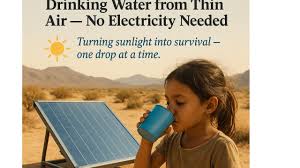MIT’s Solar-Powered Water Harvester: A Path to Clean Water in Dry Lands
Imagine waking up in a desert town where taps run dry, and every drop counts. Over two billion people face this daily struggle with safe drinking water, according to UN reports. Now, picture a simple panel on your window that pulls fresh water straight from the air using just sunlight. MIT’s solar-powered water harvester does exactly that. It turns thin air into life-saving hydration in places where rain is a rare guest. In this article, we’ll break down the tech behind it, its real effects, and what it means for a thirstier world. We’ll cover how it fights water scarcity, works in tough spots, and points to brighter days ahead.
The Global Water Scarcity Challenge
Understanding the Scale of Water Shortages
Water scarcity hits hard across the planet. More than two billion folks lack easy access to clean water, as UN data shows. This problem grows worse in dry areas due to hotter weather and more people moving in. Think of the Middle East, where rivers shrink, or sub-Saharan Africa, where wells often run empty. Climate shifts make droughts last longer, turning fertile spots into dust bowls. You can see why simple fixes won’t cut it anymore.
Impacts on Communities and Ecosystems
Bad water leads to sickness in kids and adults alike. People drink from dirty sources, risking diseases that spread fast. Farms suffer too—crops fail without steady supply, hitting family incomes. In Cape Town back in 2018, the city almost hit “Day Zero,” when all taps would stop. That scare showed how close we are to crisis everywhere. Nature takes a hit as rivers dry up, harming fish and plants that hold soil together. These stories pull at your heart, but they also push us to find smart ways out.
How MIT’s Solar-Powered Water Harvester Works
Core Technology and Design
This device grabs water vapor from the air, even when humidity dips below 20 percent. It uses special materials called metal-organic frameworks, or MOFs, that soak up moisture like a sponge. Sunlight then heats the MOFs, releasing pure water through a cycle of soak and release. No plugs or batteries needed—it runs on passive solar power. Picture it as a smart trap for invisible water in the sky.
The setup looks like a flat panel, easy to mount on walls or roofs. Air flows through, and MOFs capture the vapor overnight. By day, sun warms it up, and water drips out clean and ready. Tests show it works in super dry spots, pulling water without much fuss.
- Developed by Dr. Evelyn Wang’s team at MIT
- Uses no electricity, no moving parts, and no infrastructure
- Perfect for remote villages, disaster zones, and off-grid living
- A powerful step toward solving the global water scarcity crisis
- Prototype success shows potential to scale for families and communities
From Prototype to Practical Device
MIT started tinkering with this in 2017 in their labs. Early models pulled small amounts, but tweaks boosted output big time. Now, it’s tougher and pulls more water per size. No electricity means it fits off-grid life perfectly, like in remote villages. Researchers keep refining it for everyday use. You could see these on homes soon, changing how we think about water.
Key Innovations and Advantages Over Traditional Methods
Energy Efficiency and Sustainability
This harvester runs clean, with zero fumes or waste. Desalination plants guzzle power and spew salt back into seas, but this one skips all that. In good sun, it makes up to 2.8 liters of water per kilogram of material each day. That’s enough for a family’s basics. It cuts down on fossil fuels, helping the air stay fresh.
Solar power drives the whole thing, so it’s green from start to finish. No big machines or pipes—just sunlight doing the work.
Cost-Effectiveness and Scalability
Materials for MOFs come cheap and easy to find. That keeps build costs low, unlike pricey fog nets that need wind and mist. Atmospheric generators often need plugs, but this stays off the grid. In far-off spots, it beats hauling water by truck, which costs a fortune. Scale it up for towns, and prices drop even more.
- Low upfront investment: Basic units might cost under $100 once mass-made.
- Easy to expand: Stack panels for more yield without extra hassle.
- Long life: MOFs hold up well, cutting replacement needs.
Compared to reverse osmosis, which needs clean setups, this thrives in dust.
Limitations and Ongoing Improvements
Sunlight rules the day, so cloudy stretches slow it down. First buys might sting the wallet, though prices will fall. MIT teams work on mixes that grab water at night too. Evelyn Wang, a key researcher, notes they’re testing tougher versions for wind and sand. For your community project, check yield rates first—aim for spots with steady sun. These steps make it stronger for real use.
Real-World Applications and Case Studies
Deployment in Arid Regions
In dry zones like Arizona deserts, pilots show promise. Panels on home windows yield water for cooking and washing. Middle East tests pull steady supplies in 10 percent humidity. Families hook them to tanks for easy storage. It’s like having a personal rainmaker without clouds.
One Arizona trial gave a small town 10 liters daily from a few units. That eased pressure on shared wells.
Broader Implications for Agriculture and Disaster Relief
Farmers use it for drip irrigation on veggies, saving crops in dry spells. During floods or fires, it steps in for quick relief—no waiting for aid trucks. Links to UN Goal 6 for clean water mean global backing. MIT partners with groups to test in Africa, where it could boost small farms.
- Farm tips: Place near fields for fresh irrigate.
- Relief ideas: NGOs pack portable versions for quick setup.
- Community wins: Share units to cover more homes.
These uses spread hope, one drop at a time.
The Future of Water Harvesting Technology
Scaling Up Production and Global Adoption
Partnerships with groups like the Gates Foundation speed things up—they’ve backed MIT before. Factories could churn out thousands soon, dropping costs. Governments in dry nations might add tax breaks to help buy-in. Imagine villages in India or Chile going water-independent.
Experts predict full rollout by 2030 if funding holds.
Integration with Smart Systems and Renewables
Link it to apps that track water output via sensors. Pair with solar cells for power and water in one unit. That doubles benefits in sunny spots. Smart tweaks adjust for weather, maxing yields.
You could monitor from your phone, like checking a garden app.
Challenges to Overcome for Mainstream Use
Harsh sun and dust wear materials, so durability tests continue. Local builds cut shipping woes and create jobs. Policy pushes for rules that favor green tech. Readers, back this by writing leaders or joining funds. Insights from MIT papers show steady progress.
Conclusion
MIT’s solar-powered water harvester stands as a smart fix for dry lands. It uses simple tech to pull clean water from air, runs on sun alone, and fits real needs. From lab tests to desert trials, it proves its worth against scarcity’s toll. Key points: It eases health risks, aids farms, and scales easy. You can act now—learn about local projects or push for green policies. Follow water tech news and back efforts that quench thirst worldwide. Together, we turn dry hopes into flowing reality.

